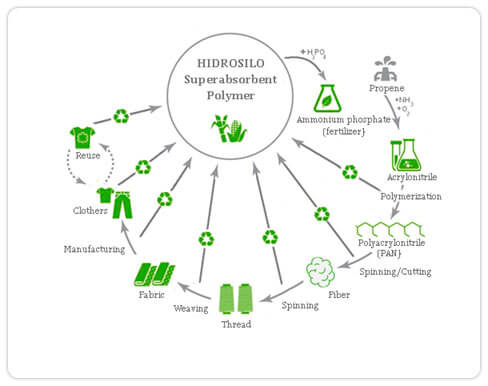SUSTAINABILITY
ENVIRONMENTAL SUSTAINABILITY
OF HIDROSILO POLYMERS
Recycling of Textile Waste
The recycling of textile and clothing waste is a potentially beneficial activity from an environmental, social and economic point of view, instead of landfilling or burning for energy production. As cities divert more and more high-volume waste streams, such as organic residue, textile recycling has been called the next frontier for countries seeking to reduce waste and environmental pollution. Most of the clothes can be recycled and sold as second-hand products, but, at some point, they end up becoming garbage, going to landfills, polluting the soil, rivers and seas. The environmental impact in these circumstances is high. Textile fibers, due to their individual characteristics and to the fashion industry which most of the time use mixtures in the threads, have a difficult recycling process.
Acrylic fibers are synthetic textile fibers and were produced since the 1950s, mainly to replace wool. Currently, its production is approximately 2 million tons per year, the third most produced in the world, after polyester – the first – and nylon – in second place.
Polyester fiber is already the most used in the world, even surpassing cotton fiber. Even cotton fiber, which is natural, has a high environmental impact, due to the large consumption of water in planting, the use of pesticides and the production of liquid effluents generated in the processing of yarns, mainly in the dyeing stage.
Therefore, the technology that the Granado Institute is developing with the use of textile waste for the production of the HIDROSILO polymer, which is a small step, promotes the environmental sustainability of the use of acrylic fibers produced by the fashion industry.

RENEWABLE SOURCE
The technology that Instituto Granado is developing for the use of textile waste for the production of HYDROSILO polymer,
which is a small step, promotes the environmental sustainability of the use of acrylic fibers by the fashion industry.